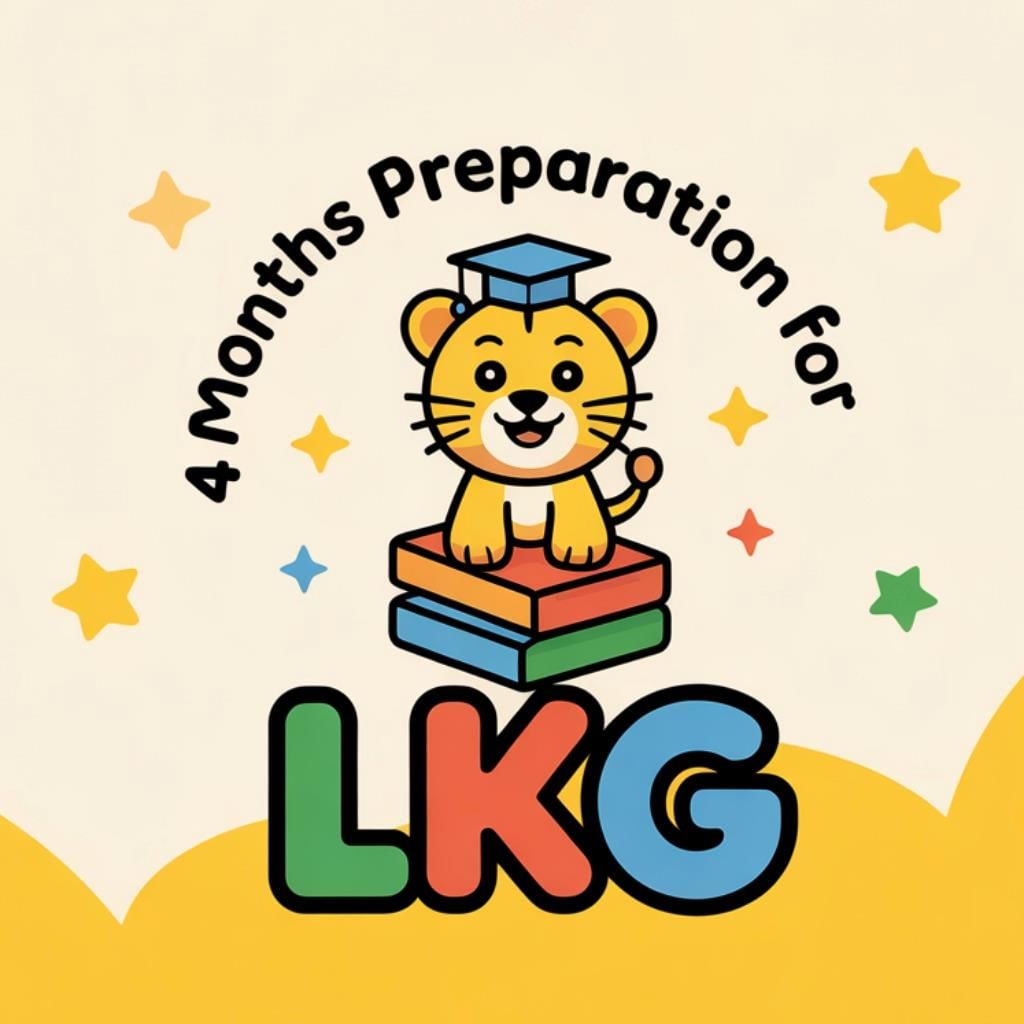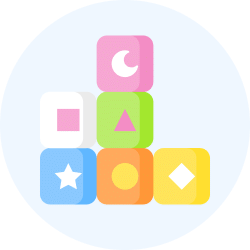
|
INFINITY COURSE
4 Months Preparation for LKG633 students learning this week · Last updated on Oct 07, 2025 |
4 Months Preparation for LKG Study Material
Trending Courses for LKG
4 Months Preparation for LKG Exam Pattern 2025-2026
4 Months Preparation for LKG Exam Pattern for LKG
Preparing for the LKG (Lower Kindergarten) exam can be an exciting journey for both children and parents. With a structured plan over four months, you can ensure that your child is ready for the challenges ahead. Below is a detailed breakdown of how to effectively prepare for the LKG exam, focusing on key areas.
Month 1: Foundation Building
- Focus on Basics: Introduce basic concepts of numbers, letters, and shapes. Use colorful flashcards to make learning fun.
- Language Development: Read simple storybooks aloud to improve vocabulary and comprehension skills.
- Motor Skills: Engage in activities that involve cutting, pasting, and drawing to enhance fine motor skills.
Month 2: Structured Learning
- Daily Routine: Establish a consistent daily routine that includes study time, playtime, and relaxation.
- Interactive Learning: Incorporate educational games that focus on letters, numbers, and shapes to reinforce learning.
- Short Worksheets: Begin introducing simple worksheets to familiarize your child with the exam format.
Month 3: Revision and Practice
- Revision Sessions: Allocate time each week for revision of previously learned material to reinforce knowledge.
- Practice Tests: Administer mock tests to familiarize your child with the exam environment and reduce anxiety.
- Feedback Loop: Discuss the results of practice tests with your child, highlighting strengths and areas for improvement.
Month 4: Final Touches
- Holistic Review: Go through all subjects, ensuring that your child feels confident in every area.
- Relaxation Techniques: Teach your child simple relaxation techniques to manage exam stress effectively.
- Parental Support: Encourage and motivate your child, and reassure them that doing their best is what truly matters.
Conclusion
The key to successful preparation for the LKG exam is a balanced approach that combines learning, practice, and emotional support. By following this structured four-month plan, you can help your child gain the confidence and skills they need to excel in their LKG examinations.
4 Months Preparation for LKG Syllabus 2025-2026 PDF Download
LKG 4 Months Preparation for LKG
Preparing for LKG (Lower Kindergarten) can be a fun and enriching experience for both parents and children. This syllabus outlines a structured plan over four months to ensure that your child is ready for LKG. Each month focuses on different key areas that are essential for a smooth transition into the world of learning.
LKG Month 1
- Introduction to Letters:
- Recognizing and tracing uppercase and lowercase letters (A-Z).
- Learning the sounds associated with each letter.
- Number Recognition:
- Identifying numbers from 1 to 10.
- Simple counting activities using everyday objects.
- Basic Shapes and Colors:
- Identifying basic shapes (circle, square, triangle).
- Recognizing primary colors and their variations.
- Fine Motor Skills:
- Activities like coloring, cutting, and pasting.
- Simple puzzles to enhance hand-eye coordination.
LKG Month 2
- Phonics and Vocabulary:
- Introduction to simple phonetic sounds.
- Building a vocabulary of basic sight words.
- Numbers and Simple Math:
- Counting from 1 to 20.
- Simple addition and subtraction using visual aids.
- Storytime and Comprehension:
- Reading short stories and discussing main ideas.
- Encouraging children to express their thoughts about the stories.
- Social Skills:
- Practicing sharing and taking turns.
- Engaging in group activities to build teamwork skills.
LKG Month 3
- Advanced Letter Recognition:
- Beginning to write letters independently.
- Recognizing letter patterns and simple words.
- Exploring Numbers:
- Counting objects up to 30.
- Introduction to number sequences (e.g., skip counting).
- Creative Arts:
- Engaging in crafts to encourage creativity.
- Drawing and painting activities related to stories.
- Physical Development:
- Participating in simple sports and physical games.
- Practicing basic yoga or stretching exercises.
LKG Month 4
- Literacy Skills:
- Identifying and writing simple words.
- Beginning to form sentences with guidance.
- Mathematical Concepts:
- Understanding basic concepts of measurement (long/short, big/small).
- Recognizing patterns and sequences in numbers.
- Emotional and Social Development:
- Discussing feelings and emotions.
- Role-playing different social scenarios.
- Preparation for Transition:
- Revising all learned concepts through fun activities.
- Encouraging independence and responsibility in tasks.
With this structured LKG 4 Months Preparation for LKG syllabus, parents can ensure their child is well-equipped to embark on their educational journey with confidence and enthusiasm!
This course is helpful for the following exams: LKG
How to Prepare 4 Months Preparation for LKG?
How to Prepare 4 Months Preparation for LKG?
Preparing for LKG (Lower Kindergarten) is an exciting journey for both parents and children. With just four months to go, it's essential to have a structured plan to ensure your child is ready for a successful start. Here are some effective strategies for the 4 Months Preparation for LKG offered by EduRev.
1. Understand the LKG Curriculum
To begin the 4 Months Preparation for LKG, familiarize yourself with the curriculum provided by EduRev. This includes key areas such as:
- Basic language skills
- Numbers and counting
- Introduction to shapes and colors
- Social skills and emotional development
2. Create a Daily Routine
Establishing a daily routine is crucial during the 4 Months Preparation for LKG. A consistent schedule helps children feel secure and ready to learn. Include:
- Set time for reading and storytelling
- Engaging in creative play
- Practicing writing and drawing
3. Focus on Language Development
Language skills are vital for LKG. Incorporate activities such as:
- Reading books together daily
- Encouraging your child to express their thoughts
- Singing songs and rhymes to enhance vocabulary
4. Introduce Basic Math Concepts
During the 4 Months Preparation for LKG, introduce your child to basic math concepts. Use fun and interactive methods like:
- Counting objects at home
- Playing simple math games
- Using educational toys that promote number recognition
5. Encourage Social Interaction
Social skills are critical for LKG readiness. Encourage your child to:
- Play with peers to develop sharing and teamwork
- Attend playgroups or community events
- Engage in role-playing scenarios
6. Enhance Fine Motor Skills
Fine motor skills are essential for writing and other classroom activities. Activities to enhance these skills during the 4 Months Preparation for LKG include:
- Drawing, coloring, and painting
- Puzzles and building blocks
- Simple crafts that involve cutting and pasting
7. Foster Independence
Encouraging independence is vital as your child prepares for LKG. Teach them to:
- Dress themselves
- Take care of personal belongings
- Follow simple instructions
8. Assess Progress Regularly
Throughout the 4 Months Preparation for LKG, regularly assess your child’s progress. This can be done by:
- Observing their interest in learning
- Conducting informal quizzes or fun assessments
- Adjusting the learning activities based on their comfort level
Conclusion
The 4 Months Preparation for LKG offered by EduRev is designed to make this transition smooth and enjoyable. By implementing these strategies, you can help your child build a strong foundation for their educational journey. Remember, the goal is to make learning fun and engaging, setting the stage for a successful start in LKG!
Importance of 4 Months Preparation for LKG
Importance of 4 Months Preparation for LKG Course
Preparing for LKG (Lower Kindergarten) is a critical step in a child's educational journey. The four months leading up to the start of this course can significantly impact a child's readiness and success in school. Here’s why this preparatory phase is essential:
1. Foundation Building
The early years of a child's education lay the groundwork for future learning. A structured 4-month preparation helps instill basic skills such as:
- Alphabet Recognition: Identifying letters and understanding their sounds.
- Number Familiarity: Introduction to numbers and basic counting.
- Fine Motor Skills: Activities like coloring and cutting that enhance hand-eye coordination.
2. Social Skills Development
Interaction with peers is crucial at this age. The preparation phase provides opportunities for children to:
- Engage in Group Activities: Learning to share and cooperate with others.
- Develop Communication Skills: Expressing thoughts and feelings verbally.
- Build Friendships: Creating bonds that can make the transition to school smoother.
3. Emotional Readiness
Starting school can be a daunting experience for young children. Four months of preparation aids in:
- Building Confidence: Encouraging independence and self-reliance.
- Understanding Routine: Familiarizing children with structured daily activities.
- Reducing Anxiety: Helping them feel more comfortable in a new environment.
4. Cognitive Skill Enhancement
Engaging children in stimulating activities during the preparatory period can boost their cognitive abilities, including:
- Problem-Solving Skills: Encouraging critical thinking through puzzles and games.
- Language Development: Expanding vocabulary through storytelling and conversations.
- Creative Thinking: Fostering creativity through arts and crafts.
5. Tailored Learning Experience
Every child is unique, and a focused 4-month plan allows for:
- Personalized Attention: Identifying individual strengths and areas for improvement.
- Adaptable Learning Methods: Employing various teaching techniques to cater to different learning styles.
Conclusion
Investing four months in preparation for the LKG course is invaluable. It equips children with the necessary skills, confidence, and mindset to embark on their educational journey. By choosing a structured program like the one offered by EduRev, parents can ensure their children are well-prepared for the exciting adventure that lies ahead.
This content is structured with clear headers and key points, and it emphasizes the importance of a four-month preparation period for children entering LKG, while also maintaining a visually appealing format.
4 Months Preparation for LKG FAQs
| 1. What is LKG and what does it stand for? |  |
| 2. How can I prepare my child for LKG in 4 months? |  |
| 3. What subjects are generally included in the LKG curriculum? |  |
| 4. What activities can help develop fine motor skills for LKG? |  |
| 5. How important is social interaction for LKG readiness? |  |
| 6. What role does play have in LKG preparation? |  |
| 7. Should I focus on academics or play in LKG preparation? |  |
| 8. How can I introduce numbers to my child before LKG? |  |
| 9. What are some effective storytelling methods for LKG preparation? |  |
| 10. How can I help my child with language development for LKG? |  |
| 11. What are some creative art activities for LKG preparation? |  |
| 12. How can I assess my child's readiness for LKG? |  |
| 13. What materials should I gather for LKG preparation? |  |
| 14. Is it necessary to enroll my child in a formal LKG program? |  |
| 15. How can I create a conducive learning environment at home for LKG? |  |
Best Coaching for 4 Months Preparation for LKG
Tags related with 4 Months Preparation for LKG

|
View your Course Analysis |

|

|
Create your own Test |

|






































